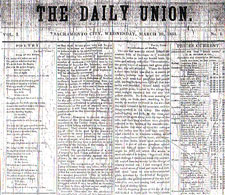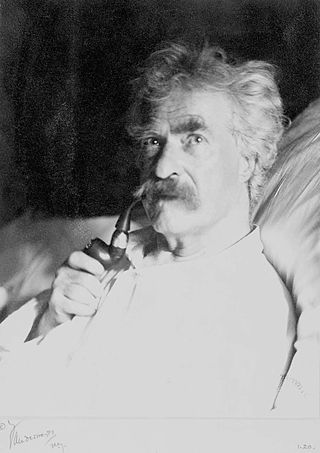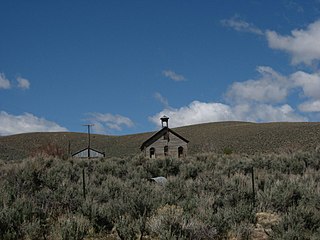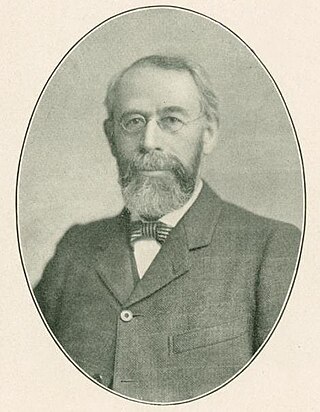
Hannibal is a city along the Mississippi River in Marion and Ralls counties in the U.S. state of Missouri. According to the 2020 U.S. Census, the population was 17,312, making it the largest city in Marion County. The bulk of the city is in Marion County, with a tiny sliver in the south extending into Ralls County.

Samuel Langhorne Clemens, known by his pen name Mark Twain, was an American writer, humorist, entrepreneur, publisher, and lecturer. He was praised as the "greatest humorist the United States has produced", and William Faulkner called him "the father of American literature". His novels include The Adventures of Tom Sawyer (1876) and its sequel, Adventures of Huckleberry Finn (1884), the latter of which has often been called the "Great American Novel". Twain also wrote A Connecticut Yankee in King Arthur's Court (1889) and Pudd'nhead Wilson (1894), and co-wrote The Gilded Age: A Tale of Today (1873) with Charles Dudley Warner.

The Buffalo News is the daily newspaper of the Buffalo–Niagara Falls metropolitan area, located in downtown Buffalo, New York. It recently sold its headquarters to Uniland Development Corp. It was for decades the only paper fully owned by Warren Buffett's Berkshire Hathaway. On January 29, 2020, the paper reported that it was being sold to Lee Enterprises.

The Sacramento Union was a daily newspaper founded in 1851 in Sacramento, California. It was the oldest daily newspaper west of the Mississippi River before it closed its doors after 143 years in January 1994, no longer able to compete with The Sacramento Bee, which was founded in 1857, just six years after the Union.

The Autobiography of Mark Twain is a lengthy set of reminiscences, dictated, for the most part, in the last few years of the life of American author Mark Twain (1835–1910) and left in typescript and manuscript at his death. The Autobiography comprises a rambling collection of anecdotes and ruminations rather than a conventional autobiography. Twain never compiled these writings and dictations into a publishable form in his lifetime. Despite indications from Twain that he did not want his autobiography to be published for a century, he serialized some Chapters from My Autobiography during his lifetime and various compilations were published during the 20th century. However it was not until 2010 that the first volume of a comprehensive collection, compiled and edited by The Mark Twain Project of the Bancroft Library at University of California, Berkeley, was published.

Unionville is a small hamlet in Pershing County, Nevada, located south of I-80 and just west of State Route 400 on Unionville Road, with the most recent population estimate being approximately 20 people. The town's best years were during the 1870s, when it was an active mining and prospecting town serving the surrounding hilly region. For a brief time, Samuel Langhorne Clemens lived there and prospected, but left without having had much success. Currently, the hamlet consists of a single business – a tourist inn – and a few small houses clustered along or near the gravel roadway which permits vehicular ingress and egress. The nearest paved road, an extension of this gravel road, is about 7 miles to the east. The nearest services of any sort, other than those available at the inn, are approximately one hour's drive away.

The Mark Twain Boyhood Home & Museum is located on 206-208 Hill Street, Hannibal, Missouri, on the west bank of the Mississippi River in the United States. It was the home of Samuel Langhorne Clemens, better known as author Mark Twain, from 1844 to 1853. Clemens found the inspiration for many of his stories, including the white picket fence, while living here. It has been open to the public as a museum since 1912, and was designated a National Historic Landmark on December 29, 1962. It is located in the Mark Twain Historic District.

Mark Twain's legacy includes awards, events, a variety of memorials and namesakes, and numerous works of art, entertainment, and media.

The Buffalo & Erie County Public Library is located on Lafayette Square, Buffalo, New York. The current facility, designed by Kideney Architects and built in 1964, replaced the original Cyrus Eidlitz Buffalo Public Library Building dedicated in February 1887. The first Buffalo Public Library, in turn, replaced the Erie County, New York courthouse, which occupied the parcel from 1816-1876.

The Warsaw Signal was a newspaper edited and published in Warsaw, Illinois during the 1840s and early 1850s. For most of its history, the Signal's editorial stance was one of vigorous anti-Mormonism and the advancement of the policies of the Whig Party.
Cowles Media Company (1935–1998) was a newspaper, magazine and information publishing company based in Minneapolis, Minnesota in the United States. The company operated Cowles Business Media, Cowles Creative Publishing, and Cowles Enthusiast Media units.

Clara Langhorne Clemens Samossoud, formerly Clara Langhorne Clemens Gabrilowitsch, was a daughter of Samuel Clemens, who wrote as Mark Twain. She was a contralto concert singer and she managed his estate and guarded his legacy after his death as his only surviving child. She was married first to Ossip Gabrilowitsch, then to Jacques Samossoud after Gabrilowitsch's death. She wrote biographies of Gabrilowitsch and of her father. In her later life, she became a Christian Scientist.
Plasmon biscuits are a biscuit containing plasmon, a proprietary dried milk. The manufacturers claimed that three pounds (1.4 kg) of plasmon equalled 100 imperial pints (57 l) of milk. Plasmon was manufactured by the International Plasmon Company and was added to a number of different products to make Plasmon Oats, Plasmon Cocoa and Plasmon Biscuits. Plasmon biscuits are still manufactured in Italy by the H. J. Heinz Company.
The Californian was a San Francisco literary newspaper published weekly from May 28, 1864 until February 1, 1868.

Mark Twain Cave — originally McDowell's Cave — is a show cave located near Hannibal, Missouri. It was named for author Mark Twain whose real name was Samuel Langhorne Clemens. Clemens lived in Hannibal from 1839 to 1853, age 4 to 17. It is the oldest operating show cave in the state, giving tours continuously since 1886. Along with nearby Cameron Cave, it became a registered National Natural Landmark in 1972, with a citation reading "Exceptionally good examples of the maze type of cavern development." The cave — as "McDougal's Cave" — plays an important role in the novel The Adventures of Tom Sawyer (1876) by Mark Twain and was renamed in honor of the author in 1880.

The Mark Twain House and Museum in Hartford, Connecticut, was the home of Samuel Langhorne Clemens and his family from 1874 to 1891. It was designed by Edward Tuckerman Potter and built in the American High Gothic style. Clemens biographer Justin Kaplan has called it "part steamboat, part medieval fortress and part cuckoo clock."

Jessie Tarbox Beals was an American photographer, the first published female photojournalist in the United States and the first female night photographer.

Josephus Nelson Larned was an American newspaper editor, author, librarian, and historian. As superintendent of the Young Men's Association Library, he presided over its transformation into what is now the Buffalo & Erie County Public Library.

The use of the pen name of Mark Twain first occurred in Samuel Clemens's writing while in the Nevada Territory which he had journeyed to with his brother. Clemens/Twain lived in Nevada from 1861 to 1864, and visited the area twice after leaving. Historians such as Peter Messent see Clemens's time in Nevada as "the third major formative period of Mark Twain's career" due to his encounters with "writers and humorists who would both shape and put the finishing touches on his literary art." The Routledge Encyclopedia of Mark Twain states that despite the few "disagreeable experiences" he had there, Twain "thrived in Nevada." Among those things he learned was "how far he could push a joke", a lesson learned from some "disagreeable experiences" he brought upon himself.

George E. Matthews (1855–1911) was president of the "J. N. Matthews Co.," which published the Buffalo Courier-Express. At the time of his death, Matthews owned the Falconwood Club in Grand Island, New York.



















